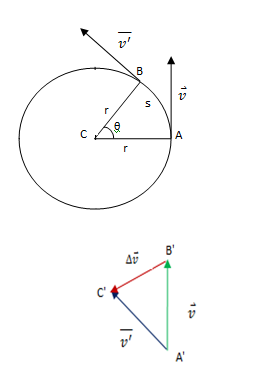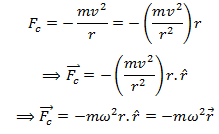Question 1: What are the centripetal acceleration and centripetal force? Derive their equations.
ANSWER
We know that when no unbalanced force is acting on a moving body, it will continue to move in a straight line with uniform velocity. A body moving in a circle or curve, therefore, is experiencing some force compelling it to move in that path.
Centripetal Force
The force, which compels a body to move in a circular path, is called centripetal (or center-seeking) force.
Mathematically,
![]() … (1)
… (1)
Centripetal Acceleration
The change in the direction of the velocity of the body produces acceleration that is directed to the center of the circle, called centripetal (or center-seeking) acceleration, denoted by ![]() .
.
Mathematically,
![]() … (2)
… (2)
Equation for centripetal acceleration
Consider a body of mass m is moving with uniform velocity v in a circle of radius r and center at C. At point ‘A’ at time t1, velocity of the body is ![]() . Then at point ‘B’ when time is t2, its velocity changes to
. Then at point ‘B’ when time is t2, its velocity changes to ![]() . Now let us construct a triangle A’B’C’ so that A’B’ is equal and parallel to
. Now let us construct a triangle A’B’C’ so that A’B’ is equal and parallel to ![]() and A’C’ is equal and parallel to
and A’C’ is equal and parallel to ![]() . As the speed does not change, the velocity has the same magnitude with a changed direction. The change in velocity is
. As the speed does not change, the velocity has the same magnitude with a changed direction. The change in velocity is ![]() in a time interval Δt = t2– t1.
in a time interval Δt = t2– t1.
When Δt is very small, Δ![]() is also very small and the arc
is also very small and the arc ![]() is approximately equal to cord AB. Then on comparison, ΔACB and ΔA’B’C’ are isosceles. So,
is approximately equal to cord AB. Then on comparison, ΔACB and ΔA’B’C’ are isosceles. So,
![]()
If Δt is very small, and hence do θ, point B is very close to point A, then,
S = rΔt
Use this value of ’s’ in the above equation.
![]()
The RHS is the instantaneous acceleration. Thus
![]()
This is the required equation of centripetal acceleration.
In vector form,

Here ![]() is the centripetal acceleration.
is the centripetal acceleration.![]() is the unit vector along the radius acting outward from the center of the circle.
is the unit vector along the radius acting outward from the center of the circle.
Both the centripetal acceleration and the radius vector are, therefore, opposite in direction with each other. Therefore, we have,

This is the equation of centripetal acceleration.
Equation for centripetal force
From Newton’s Second Law of Motion, F = ma
Putting the value of acceleration, we get,

This is the required equation for the centripetal force.

Pingback:Derive equation of angular-momentum – msa
Pingback:Comprehensive Questions on Rotational and Circular motion, Physics 11 – msa
Pingback:Comprehensive Questions, Rotatory and Circular Motion. – msa
Pingback:index-lq-ch5-p11